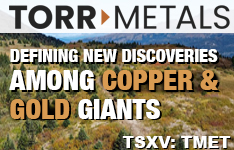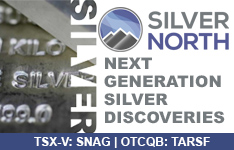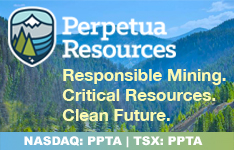The Gold Report: What was the mood at the Prospectors and Developers Association of Canada annual meeting? Did any companies stand out to you?
Brent Cook: There was an overall lack of "buzz" and news releases. Although many companies seemed to time news for the event, not many had market moving news. It seemed most companies were keeping their heads down.
Chris Berry: Most were realistic. It is clear that the days of having the wind at the back of the mining industry based on China's increasing appetite for a host of commodities, is over—or at least paused. Companies across all market capitalizations have written down the value of assets, sold properties at a discount, and instituted strict cost discipline going forward.
Jordan Roy-Byrne: What stood out to me was the muted bullish sentiment or cautious optimism from the industry.
Adrian Day: While crowds were thinner, the mood was a little more optimistic, though realistic. Many companies were looking for projects, joint ventures and other deals.
Mirasol Resources Ltd.'s (MRZ:TSX.V) news of a management transition in the middle of the conference obviously attracted attention. One does not normally expect that kind of news during a major show!
Reservoir Minerals Inc. (RMC:TSX.V), with its fabulous discovery in Serbia as well as an exceptionally strong stock price, received lots of attention.
Eric Coffin: I saw no evidence of conditions that would lead to a "PDAC curse." Traffic was understandably lighter, but generally optimistic. Traders were pleasantly surprised by the lift in gold prices the first few weeks of March, but not overly aggressive. Many of them are worried about a post-PDAC pullback but I think that pullback is unlikely unless metal prices suddenly tanked.
The tsunami of press releases that normally comes out as companies save their news for this event was not there and the ones that did release didn't get really big reactions for the most part.
At the pre-PDAC Subscriber Investment Summit I hosted just before the show with Keith Schaefer and Lawrence Roulston, Columbus Gold Corp. (CGT:TSX.V) announced a pretty good set of holes from its Paul Isnard project in French Guiana. That one did get a pretty good reaction. The company reported good results from one end of the smaller mineralized horizon. This is a 30,000-meter drill program that will generate a lot of news and I think will increase both the size and confidence level of the resource. Columbus has one of the better looking charts.
SilverCrest Mines Inc. (SVL:TSX; SVLC:NYSE.MKT) was also very exciting. President N. Eric Fier is always compelling. With 30% revenue increases, what is not to like?
The market bottomed last summer, as I said at the time, but there were no catalysts to move it much higher. There are more reasons now, with a stronger gold market and seller exhaustion. I think physical demand and renewed ETF buying should be enough for gold to reach my current $1,400/ounce target and I may raise that. We will see 30%+ increases in the TSX Venture Index this year.
TGR: Were conference attendees worried about the impact of geopolitics on mining portfolios?
CB: The crises in Ukraine and Venezuela bring this question to the fore. Additionally, issues like slowing growth in China, inflationary pressures in emerging markets and resource nationalism appear set to provide investment opportunities, but also wipe out unsuspecting or careless resource investors.
TGR: What is a realistic portfolio today?
CB: I still see excess capacity across the industry, with the number of companies exploring for various metals/minerals, in particular. The paradox is that there are some tremendously undervalued opportunities out there, but with so many investors snakebitten from losses in recent years and a distinct lack of M&A activity on the part of the majors, these companies could stay undervalued for a while. I am still optimistic over the medium to long term because of underlying commodity demand. Population dynamics and the ubiquity of technology dictate that many more individuals in the future are poised to live more commodity-intensive lifestyles.
That said, I am a long-term optimist about commodities and emerging market growth and think that as long as investors are selective and have a disciplined strategy and approach, they can take advantage of opportunities.
"Columbus Gold Corp. has one of the better looking charts."
A key takeaway from PDAC this year was that all commodities are not created equal. Uranium is clearly the belle of the ball right now. Differentiation and diversification among metals and across the value chain are keys to success going forward, if you're investing at this stage of the cycle. It is increasingly clear that large projects are being reevaluated in favor of smaller projects better able to fit into current and future demand forecasts. This is a good development.
On an additional positive note, there does seem to be a flurry of significant financings taking place, with NexGen Energy Ltd. (NXE:TSX.V) announcing a $10 million ($10M) bought-deal most recently. This is good news, specifically for the sustainability of junior uranium companies. If more financings of this type can be completed across various commodities, I think many of the questions I listed above will have been answered with a favorable outcome.
It was also abundantly clear that money is pooling and consolidating assets across a host of metals in the precious and base categories. Private equity money has moved into the mining sector and is intent on consolidating properties, recapitalizing companies and potentially spinning them out. Again, this is a longer-term positive sign for the industry as a whole, but differs from one metal to the next.
You can't rely on Elon Musk (Tesla [TSLA:NASDAQ]) or Russian President Vladimir Putin to boost metals prices sustainably. This may sound silly, but it's true. With the recent announcement of Tesla's gigafactory, share prices of U.S. and Canada-based lithium exploration and development plays exploded through the roof. Similarly, Putin's movement of Russian troops into Ukraine sent gold and silver much higher. These isolated events tell us nothing about true supply and demand dynamics of commodities, and everything about speculation and the fear and greed paradigm in financial markets.
Only organic growth, technological breakthroughs and sound fiscal and monetary policies will provide the basis for increasing and sustaining demand. The travails in the mining markets today are setting the stage for the next move higher, but I continue to believe that a mixed global growth picture and excess capacity have delayed this move into the future. Patience and selectivity are still the most prudent ways forward and can be rewarding in the interim, as we've seen with select uranium plays.
TGR: Crowdsourcing was presented as one solution to the financing challenges juniors face today. Do you think that is realistic?
AD: I believe it is already too easy for exploration companies to raise money and crowdsourcing would likely mean that more ill-informed investors put more money into marginal projects, which would not be good for the industry. But I also don't want more regulation and more restrictions; people need to do their own homework.
EC: I am not sure crowdsourcing will work with regulators. It has become more difficult for investors to get involved rather than easier. I do hope they succeed because the retail investor is critical to the space.
I have heard about a lot of private equity investment out there waiting for the right deal and it is getting more realistic about the level of development it is willing to look at. I was, frankly, surprised by the number of European fund managers at PDAC this year. That is definitely a sign.
CB: I'm really not sure about crowdfunding because I don't think it will make a surmountable difference to the fate of many of the companies. If a company is able to raise $250,000 through crowdfunding, what difference does that make when the company needs $250M (a thousand times as much) to get into production? Maybe it pays some bills and salaries, but doesn't "move the needle" forward. I just don't see crowdfunding as a realistic way forward, but I do applaud the realization that a new paradigm for company financing is necessary.
TGR: What did you hope that attendees took away from your presentation at the conference?
AD: I tried to put the current rally in perspective by looking at the main factors that caused gold to decline last year and whether they had changed. I hope attendees took away the message that despite the strong rally since mid-December, and notwithstanding the strong possibility of a pullback soon, this rally has only just begun. In my view, gold has bottomed, and it would be a mistake to sell it too soon.
JRB: I discussed some of my rules for proper portfolio management such as 1) sell anything that goes down 20% after you bought, 2) focus on a limited number of stocks so you can become an expert on all, and 3) overweight your favorite companies in your portfolio.
BC: My talk focused on the geological, financing and political reasons economic metal discoveries are so rare. This leads into what I think will be a very important tipping point when the mining companies realize there are not enough new deposits to replace current production.
EC: My talk, "You Can Come Out Now," pretty much summed up my feelings about the state of the junior mining market now. This is not a "rising tide lifts all boats" market and I don't expect it to be for some time. But well-managed companies with good targets that know how to finance will have a good year.
Chris Berry, with a lifelong interest in geopolitics and the financial issues that emerge from these relationships, founded House Mountain Partners in 2010. The firm focuses on the evolving geopolitical relationship between emerging and developed economies, the commodity space and junior mining and resource stocks positioned to benefit from this phenomenon. Berry holds a master's degree in business administration (finance) with an international focus from Fordham University, and a bachelor's degree in international studies from the Virginia Military Institute.
Eric Coffin is the editor of the HRA (Hard Rock Analyst) family of publications. Responsible for the "financial analysis" side of HRA, Coffin has a degree in corporate and investment finance. He has extensive experience in merger and acquisitions and small-company financing and promotion. For many years, he tracked the financial performance and funding of all exchange-listed Canadian mining companies and has helped with the formation of several successful exploration ventures. Coffin can be reached at [email protected] or the website.
Brent Cook brings more than 30 years of experience to his role as a geologist, consultant and investment adviser. His knowledge spans all areas of the mining business, from the conceptual stage through detailed technical and financial modeling related to mine development and production. Cook's weekly Exploration Insights newsletter focuses on early discovery, high-reward opportunities, primarily among junior mining and exploration companies.
Adrian Day, London-born and a graduate of the London School of Economics, heads the eponymous money management firm Adrian Day Asset Management (www.adriandayassetmanagement.com; 410-224-2037), where he manages discretionary accounts in both global and resource areas. Day is also sub-adviser to the new EuroPacific Gold Fund (EPGFX). His latest book is "Investing in Resources: How to Profit from the Outsized Potential and Avoid the Risks."
Jordan Roy-Byrne is a Chartered Market Technician, a member of the Market Technicians Association and a former official contributor to the CME Group, the largest futures exchange in the world. He is the editor of The Daily Gold Premium, and his work has been featured in CNBC, Barron's, Financial Times, Alphaville, Yahoo Finance, Business Insider, 321Gold, Gold-Eagle, FinancialSense, GoldSeek and Kitco.
Read what other experts are saying about:
Want to read more exclusive Gold Report interviews like this? Sign up for our free e-newsletter, and you'll learn when new articles have been published. To see a list of recent interviews with industry analysts and commentators, visit our Exclusive Interviews page.
DISCLOSURE:
1) JT Long conducted this interview for The Gold Report and provides services to The Gold Report as an employee. She or her family own shares of the following companies mentioned in this interview: None.
2) The following companies mentioned in the interview are sponsors of The Gold Report: Columbus Gold Corp. and SilverCrest Mines Inc. Streetwise Reports does not accept stock in exchange for its services or as sponsorship payment.
3) Chris Berry: I or my family own shares of the following companies mentioned in this interview: None. I personally am or my family is paid by the following companies mentioned in this interview: None. My company has a financial relationship with the following companies mentioned in this interview: None.
4) Eric Coffin: I or my family own shares of the following companies mentioned in this interview: Columbus Gold Corp. and SilverCrest Mines Inc. I am never paid by companies to follow them or feature them in my publications. My company has no financial relationships with companies followed in the HRA Advisories newsletters though I may be—and usually am—a shareholder in companies I talk about. I was not paid by Streetwise Reports for participating in this interview. Comments and opinions expressed are my own comments and opinions. I had the opportunity to review the interview for accuracy as of the date of the interview and am responsible for the content of the interview.
5) Adrian Day: I or my family own shares of the following companies mentioned in this interview: None. I personally am or my family is paid by the following companies mentioned in this interview: None. My company holds shares of the following companies mentioned in this interview for money management clients: Reservoir Minerals Inc. and Mirasol Resources Ltd., and is a 5% reporting holder of Reservoir. I was not paid by Streetwise Reports for participating in this interview. Comments and opinions expressed are my own comments and opinions. I had the opportunity to review the interview for accuracy as of the date of the interview and am responsible for the content of the interview.
6) Brent Cook: I was not paid by Streetwise Reports for participating in this interview. Comments and opinions expressed are my own comments and opinions. I had the opportunity to review the interview for accuracy as of the date of the interview and am responsible for the content of the interview.
7) Jordan Roy-Byrne: I was not paid by Streetwise Reports for participating in this interview. Comments and opinions expressed are my own comments and opinions. I had the opportunity to review the interview for accuracy as of the date of the interview and am responsible for the content of the interview.
8) Interviews are edited for clarity. Streetwise Reports does not make editorial comments or change experts' statements without their consent.
9) The interview does not constitute investment advice. Each reader is encouraged to consult with his or her individual financial professional and any action a reader takes as a result of information presented here is his or her own responsibility. By opening this page, each reader accepts and agrees to Streetwise Reports' terms of use and full legal disclaimer.
10) From time to time, Streetwise Reports LLC and its directors, officers, employees or members of their families, as well as persons interviewed for articles and interviews on the site, may have a long or short position in securities mentioned and may make purchases and/or sales of those securities in the open market or otherwise.

 PDAC curse or blessing? Fresh from the Letter Writer Presentations track at the Prospectors and Developers Association of Canada (PDAC) conference,
PDAC curse or blessing? Fresh from the Letter Writer Presentations track at the Prospectors and Developers Association of Canada (PDAC) conference,








































